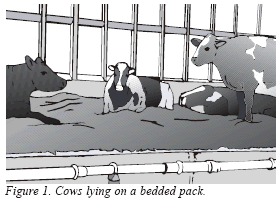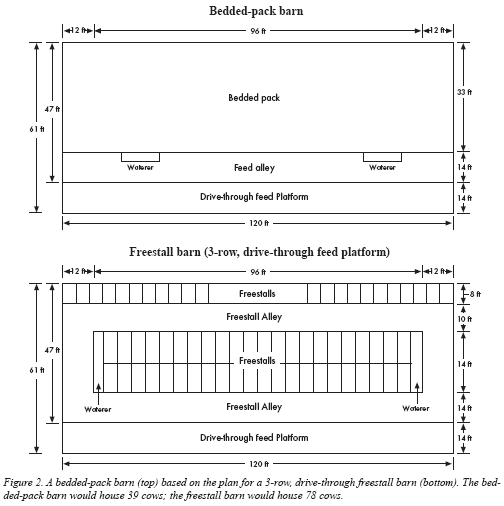



Bedded-pack Dairy Barns
By Susan W. Gay, Extension Engineer, Biological Systems Engineering.
Bedded-pack barns are an alternative type of dairy housing for producers wanting to upgrade or modernize their milking herd facilities while minimizing capital costs. These barns provide cows with a large bedded pen for resting rather than individual stalls (Figure 1). Bedded pack refers to the mixture of bedding, usually wood shavings or kiln-dried sawdust, and manure on the pen floor. A properly managed bedded pack provides a healthy, comfortable surface on which cows may lie.
Why Build a Bedded-pack Barn?
Numerous economic factors must be considered before deciding to build a bedded-pack barn. Bedded-pack barns have lower capital costs compared to freestall barns because bedded-pack barns require less concrete (the bedded pack is built up on clay) and equipment. Furthermore, there is less investment in manure storage structures because the bedded pack provides storage.The lower capital costs for bedded-pack barns may be offset by higher annual costs for bedding. Approximately three to four times more bedding is used in a bedded-pack barn as in a freestall barn. Labor requirements are similar for both types of barns. Properly maintained bedded-pack barns require more daily labor; packs must be stirred twice daily and must have dry bedding added. However, less daily labor is required for manure handling.
Studies have indicated that certain types of lameness occur less frequently in heifers on bedded packs than in heifers in freestall barns.1 Decreased lameness may lead to increased milk production and longevity. Many producers have a bedded-pack barn for cows with special needs including cows due to calve and lame cows because of the increased cow comfort provided by the bedded pack.
Bedded-pack barns may be ideal facilities for small herds. These barns provide flexibility in housing different groups of cows in varying stages of lactation while consolidating feeding and manure handling. Furthermore, cows can be added to these barns without additional capital costs until the recommended space per cow is reached.
Facility Design
Most bedded-pack barns are based on plans for three-row, drive-by, freestall barns (Figure 2). Using such a plan allows for conversion from a bedded-pack barn to a freestall barn if necessary. In a bedded-pack barn, the freestalls and freestall alleys are replaced by the bedded pack.A feed alley is located along one side of the bedded pack. Waterers are located in the feed alley. The recommended feed alley width is 14 feet because cows eat off one side of the alley and drink from waterers on the other side.

The bedded pack must provide 100 sq ft per cow. However, 140 sq ft per cow is recommended for close-up dry or convalescing cows. The bedded pack should be enclosed by a 4-foot high concrete wall to prevent feed and water from spilling onto the pack and to limit access points. The wall that separates the feed alley and the bedded pack should have a fence to prevent cows from walking over the wall.
Sizing a Bedded-pack Area - Example
A dairy producer plans to build a bedded-pack barn for 60 cows. The bedded pack will be 33 feet wide because it is based on the freestall barn in Figure 2. Determine the length of the bedded-pack barn using the recommended space of 100 sq ft per cow.
Bedded-pack area = 60 cows x 100 sq ft/cow = 6,000 sq ft
Length of barn = 6,000 sq ft ÷ 33 ft = 181 ft
Actual barn dimensions will be 61 ft by 181 ft.
Good ventilation is essential to maintain a dry bedded-pack surface. Sidewall height should be 14 to 16 feet to enhance natural ventilation. Sidewall curtains are recommended to control ventilation throughout the year. Mixing fans should be installed over the bedded-pack area to increase surface drying. These fans will also provide a cooling draft over cows during hot weather. A 3-foot overhang will minimize the amount of roof runoff and rain that may be blown onto the bedded pack. More information on natural ventilation of dairy barns is available from Natural Ventilation for Freestall Dairy Barns, Virginia Cooperative Extension publication 442-763.
Bedding
Softwood shavings are highly recommended for bedded-pack barns because pine, cedar, and other softwoods support minimal bacterial growth. Wood shavings are preferred over sawdust because the small size of sawdust particles can enhance bacterial growth and irritate teat ends. Sawdust should be kiln-dried if used as bedding. Studies have indicated that green hardwood sawdust can lead to increased mastitis in dairy cows. Some producers use straw bedding, although it is also associated with higher incidences of mastitis.Management of the Bedded Pack
Bedded packs must be properly managed to maintain a healthy and comfortable cow environment. Proper pack management requires twice daily stirring to a depth of 10 to 12 inches. Stirring incorporates oxygen into the bedding to prevent anaerobic decomposition which does not generate the temperatures necessary to kill pathogens and may cause unpleasant odors. The bedded pack should be stirred while the cows are being milked. Stirring can be done using a small loader with a front-mounted adapted cultivator or tines mounted on the front of the loader. A sufficient amount of dry bedding is essential to keep cows clean and SCC (somatic cell count) low. Daily bedding requirements can range from 10 to 35 lb of bedding per cow depending on the size of the cow. Lactating cows produce more manure than dry cows, so will require more bedding. Hot and humid or wet weather will require more frequent application of fresh bedding than dry weather. Fresh bedding should be added when the bedding becomes moist enough to stick to cows after they rise from laying on the bedded pack.A minimum 100 sq ft per cow must be provided to maintain the integrity of the bedded pack. Bedded-pack barns are easy to overpopulate because there are no stalls. These barns should look like there is room for another cow. However, it is important not to exceed the number of cows for which the barn is designed.
Manure Management
Bedded packs should be completely cleaned out each fall and applied to cropland as part of a manure management plan. All or some of the bedded pack can also be removed in the spring before fields are planted. Use caution when removing the bedded pack during clean out to avoid disturbing the clay base. The feed alley should be scraped daily and the manure stored until land applied according to a manure management plan. A mini-pit for short-term storage could be considered in some cases.Summary
Bedded-pack barns are a low capital-cost alternative to freestall barns. However, the lower initial investment for bedded-pack barns may be offset by higher annual costs. Daily labor requirements are similar for both systems. The decision to build a bedded-pack barn should include consideration of both capital and annual costs for this type of barn. Many freestall barns have started out as bedded-pack barns until enough capital was saved to add freestalls and freestall alleys. Freestall barns evolved from bedded-pack barns to reduce bedding costs and the amount of labor spent on bedding management.Bedded-pack barns require careful and consistent daily management to create a healthy and comfortable cow environment. Poorly managed bedded packs can quickly degrade to a mire of wet manure and bedding. Effective pre-milking cow preparation is also required to maintain low bulk tank SCC.
Acknowledgements
The author would like to express her appreciation for the review and comments made by Robert "Bobby" Grisso, Professor and Extension Engineer, Biological Systems Engineering; Robert James, Professor, Dairy Science; and Tina Horn, Extension Dairy Agent, Augusta County.
For Additional Information
On Natural Ventilation
Natural Ventilation for Freestall Dairy Barns, Virginia Cooperative Extension publication 442-763
On Site Selection
Site Selection for Dairy Housing Systems, Virginia Cooperative Extension publication 442-096
Sources
Livesey, C.T. 2002. Hock injuries in cattle kept in straw yards or cubicles with rubber mats or mattresses. The Veterinary Record 150(22): 677-679. Webster, A.J. F. 2002. Effects of housing practices on the development of foot lesions in dairy heifers in early lactation. The Veterinary Record 151(1): 9-12.
March 2006



